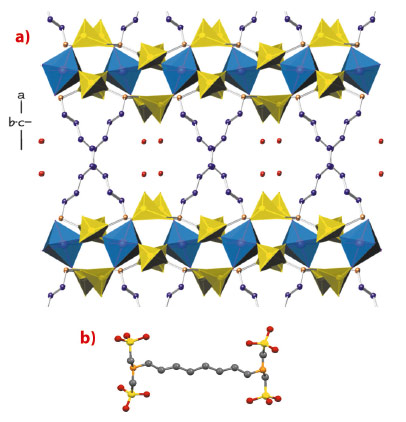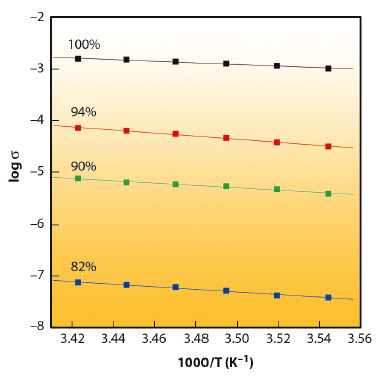- Home
- Users & Science
- Scientific Documentation
- ESRF Highlights
- ESRF Highlights 2012
- Structure of materials
- High proton conductivity in a flexible, cross-linked, ultramicroporous magnesium tetraphosphonate hybrid framework
High proton conductivity in a flexible, cross-linked, ultramicroporous magnesium tetraphosphonate hybrid framework
Multifunctional metal phosphonates are thermally and chemically stable hybrid materials (metal-organic frameworks, MOFs) possessing a great diversity of architectures and properties [1]. Their unique structural architectures, framework flexibility and their Brönsted acidity (mainly derived from POH groups), make them attractive materials for proton conductors and sensors, as well as for many other possible applications such as gas storage, catalysis, photochemistry, etc.
We focused our attention on diaminotetraphosphonic acids, in particular hexamethylenediamine-N,N,N’,N’-tetrakis(methylenephosphonic acid), H8HDTMP and octamethylenediamine-N,N,N’,N’-tetrakis(methylenephosphonic acid), H8ODTMP, as suitable organic ligands. These tetraphosphonic acids are versatile organic linkers which show different coordination modes to the cations, as well as different arrangements of the alkyl chains. These features are evident in new adsorbate-responsive materials [2], and/or 3D-ultramicroporous materials with high proton conductivity [3]. The systematic study of synthesis conditions, using a high-throughput methodology, has permitted the optimum conditions for crystallisation to be determined for a new magnesium hybrid material, MgH6ODTMP·2H2O(DMF)0.5 (DMF stands for dimethylformamide). Its crystal structure was solved by the recently-developed Patterson-function direct methods from high-resolution synchrotron powder X-ray diffraction data collected at beamline ID31 [4]. This type of direct method can accurately resolve clusters of overlapped reflections, so that the effective resolution of the extracted intensity data is extended.
MgH6ODTMP·2H2O(DMF)0.5 shows a novel open-framework 3D pillared structure, see Figure 129. The inorganic layers are built by MgO6 octahedra and O3PC tetrahedra. Neighbouring layers are connected along the a axis by the organic groups (CH2)22–NH–(CH2)8–NH–(CH2)2 in cross-diagonal fashion. This linkage results in an open-framework, with two types of 1D channel filled by water and remnant DMF molecules.
The aliphatic –(CH2)8– chain of the ligand provides substantial framework flexibility, with the cavities adapting to the guest molecules (water). Thus, after dehydration (thermal or under vacuum) and rehydration cycles, new crystalline phases can be obtained, with the highest hydrated phase having the composition MgH6ODTMP·6H2O. X-ray powder diffraction using a laboratory source indicated that a crystalline-quasi-amorphous-crystalline transformation takes place for a complete cycle of dehydration/rehydration, while the integrity of the framework is maintained. Moreover, depending on temperature and water partial pressure, intermediate phases with different hydration states were identified, from the anhydrous phase, MgH6ODTMP, to the most hydrated state, MgH6ODTMP·6H2O. Therefore, the compound is more appropriately formulated as MgH6ODTMP·nH2O, with 0 ≤ n ≤ 6.
 |
|
Fig. 129: a) View of the 3D pillared open-framework (MgO6) octahedra blue; CPO3 tetrahedra yellow; C cyan; O red: N orange. b) Schematic representation of the tetraphosphonate ligand, H8ODTMP. |
The gas adsorption/separation features of the anhydrous phase correspond to an ultramicroporous material with a maximum CO2 uptake of 1.2 mmol/g, at 900 kPa and a relatively high selectivity towards CO2 adsorption in CO2/CH4 mixtures. This separation ability could be useful for natural gas upgrading.
 |
|
Fig. 130: Arrhenius plots of log σT for MgH6ODTMP·6H2O at four different levels of relative humidity. |
On the basis of these structural features, a preliminary study to characterise the proton conductivity features of the magnesium tetraphosphonate hybrid material has been carried out. A small temperature range (282-292 K) was selected to ensure constant water content at a given water partial pressure. High proton conductivity, up to a maximum value of σ = 1.6 10-3 S·cm-1 (T = 292 K), was observed for the fully-hydrated phase, i.e. MgH6ODTMP·6H2O, at a relative humidity of ~ 99%. The relatively low activation energy values, between 0.1 - 0.5 eV, are consistent with a Grotthuss transfer mechanism, via water molecules (Figure 130). It must be underlined, however, that small changes in water partial pressure (from ~ 1.8 to ~ 2.2 kPa) modify the proton conductivity by up to four orders of magnitude very likely due to a change in the water content of the solid. Other hybrid materials based on tetraphosphonate ligands, with different topologies and structural features, are currently being investigated in order to establish structure-property correlations.
Principal publication and authors
R.M.P. Colodrero (a), P. Olivera-Pastor (a), E.R. Losilla (a), D. Hernández-Alonso (a), M.A.G. Aranda (a), L. Leon-Reina (b), J. Rius (c), K.D. Demadis (d), B. Moreau (e), D. Villemin (e), M. Palomino (f), F. Rey (f) and A. Cabeza (a), Inorg. Chem. 51, 7689-7698 (2012).
(a) Departamento de Química Inorgánica, Universidad de Málaga (Spain)
(b) Servicios Centrales de Apoyo a la Investigación, Universidad de Málaga (Spain)
(c) Institut de Ciència de Materials de Barcelona, Catalunya (Spain)
(d) Crystal Engineering, Growth and Design Laboratory, Department of Chemistry, University of Crete (Greece)
(e) Laboratoire de Chimie Moléculaire et Thioorganique, ENSICAEN & Université de Caen (France)
(f) Instituto de Tecnología Química (UPV-CSIC), Valencia (Spain)
References
[1] Metal phosphonate chemistry: From synthesis to applications, A. Clearfield, K.D. Demadis, Eds. The Royal Society of Chemistry: London (2012).
[2] R.M.P. Colodrero, A. Cabeza, P. Olivera-Pastor, A. Infantes-Molina, E. Barouda, K.D. Demadis and M.A.G. Aranda, Chem. Eur. J. 15, 6612-6618 (2009).
[3] R.M.P. Colodrero, P. Olivera-Pastor, E.R. Losilla, M.A.G. Aranda, L. León-Reina, M. Papadaki, A.C. McKinlay, R.E. Morris, K.D. Demadis and A. Cabeza, Dalton Trans. 41, 4045-4051 (2012).
[4] J. Rius, Acta Cryst A67, 63-67 (2011).



